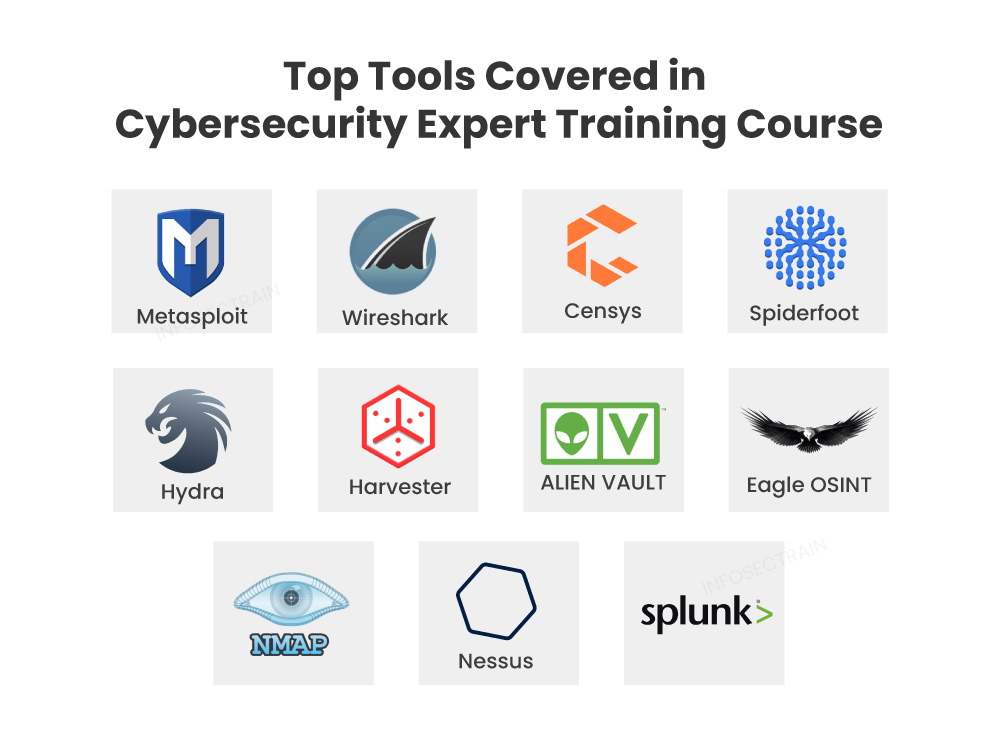Top Tools Covered in Cybersecurity Expert Training Course
The cybersecurity field constantly evolves, and staying ahead of cyber threats requires expertise in utilizing the right tools. A cybersecurity expert training course provides individuals with the essential knowledge and skills to effectively protect digital systems and networks. This training course, which covers a wide range of tools, helps professionals gain the skills they require to identify vulnerabilities, identify intrusions, manage incidents, and implement effective security measures. These tools span various areas, including network security, vulnerability assessment, intrusion detection, incident response, encryption, etc. Through practical hands-on experience, participants gain proficiency in utilizing these tools to enhance cybersecurity defenses, mitigate risks, and safeguard critical assets and sensitive data. By understanding the functionalities and applications of these tools, cybersecurity experts are well-prepared to tackle the ever-evolving challenges of the cybersecurity landscape and ensure the resilience and integrity of digital environments.

Top Tools Covered in Cybersecurity Expert Training Course
A cybersecurity expert training course typically covers various tools and technologies for securing IT systems, networks, and data. The following is a list of top tools commonly covered in cybersecurity expert training course:

1. Metasploit: Metasploit is a comprehensive Ruby-based framework for penetration testing. It facilitates the creation, testing, and execution of exploit code, offering flexibility, robustness, and a wide array of tools for both straightforward and intricate tasks.
Features
- Payload and Exploit Creation: Empowers security researchers to craft payloads and exploits for testing purposes.
- Payload and Exploit Library: Offers a vast repository with over 592 payloads and 2074 exploit groups.
- Modularity with Add-ons: Incorporates extra add-ons, extending functionality and customization options.
- Shell Options: Provides both Bind Shell and Reverse Shell capabilities for varied approaches.
- Automated Clean-up: Facilitates automatic removal of the infected system.
- Payload Flexibility: Allows seamless swapping between payloads, optimizing testing strategies
2. Wireshark: Wireshark is a prominent software utility employed for monitoring network traffic via network interfaces. Wireshark is the foremost network monitoring tool widely embraced across diverse roles, from System Administrators and Network Engineers to security professionals and hackers.
Features
- Packet Monitor: Visual representation of network packets, including color-coded types, source/destination addresses, packet content in text and hex, and port details.
- Import from Capture Files: Supports multiple file formats, including pcapng, libpcap, Oracle snoop, Network Monitor, and more, for importing packet dumps.
- Export to Capture Files: It enables saving results in various formats like pcapng, libpcap, Network Monitor, and others for future analysis.
3. Censys: Censys is a search engine that provides information about hosts, services, certificates, and more on the internet. It offers valuable insights for security professionals and researchers.
Features
- Host and Service Enumeration: Provides detailed information about specific hosts or services, including IP addresses, open ports, and banners.
- Certificate Search: Offers a comprehensive search functionality for certificates and certificate authorities, providing insights into SSL/TLS configurations
- Internet-Wide Scanning: Employs techniques for scanning many hosts, offering a broad view of the internet landscape.
- API Access: Provides a powerful API for integration with other tools and services, allowing custom data analysis and automation.
4. Spiderfoot: Spiderfoot is an Open-Source Intelligence (OSINT) gathering tool. It automates the process of collecting information from various sources to perform reconnaissance and obtain insights about targets.
Features
- Data Gathering: Queries multiple data sources, including search engines, social media, DNS records, and more, to aggregate information into a comprehensive report.
- Reconnaissance: Gathers target information like online presence, domains, IP addresses, email addresses, and related entities to map the target’s digital footprint.
- Vulnerability Identification: Searches for potential vulnerabilities such as open ports, exposed services, outdated software, and known security issues.
- Threat Intelligence: Uses threat intelligence feeds to detect indicators of compromise (IOCs) like malicious IP addresses, domains, and email addresses.
- Email and Username Enumeration: Collects associated email addresses and usernames from various sources.
5. Hydra: Hydra is a parallelized login cracker that supports multiple protocols for attacking specific targets. Renowned for its speed and versatility, Hydra facilitates the effortless integration of new modules. This tool enables researchers and security professionals to demonstrate the potential ease of unauthorized remote system access.
Features
- Diverse Protocol Support: Hydra’s extensive protocol compatibility is a standout trait, encompassing FTP, POP3, IMAP, SSH, VNC, and more.
- Optimal Performance: With impressive speed and efficiency, Hydra excels in delivering rapid results, enhancing productivity.
- Broad Device Compatibility: Hydra’s versatility extends to seamless integration with various devices, ensuring widespread usability.
- Parallel Brute Force Attacks: Hydra facilitates swift and powerful operations, enabling users to launch parallel brute force cracking attacks.
6. Harvester: A tool called Harvester can be used to gather email addresses from various sources. This information may be employed in phishing attempts or for marketing purposes.
Features
- Email Harvesting: Scans websites and search results to extract email addresses for marketing campaigns or contact lists.
- Subdomain Enumeration: Identifies additional web assets by enumerating subdomains associated with a target domain.
- Automation and Bulk Processing: Automates data collection, enabling quick gathering of large amounts of information.
7. AlienVault: AlienVault, powered by AT&T, offers Unified Security Management (USM), a comprehensive approach that integrates various cybersecurity services and protocols. It combines asset discovery, SIEM, log management, intrusion detection, and incident reporting into a single platform
Features
- Automated Data Analysis: The platform employs smart automation to collect and analyze data, enabling efficient threat detection and rapid response to potential risks.
- Incident Response Suite: AlienVault equips organizations with a comprehensive suite of incident response tools, aiding in swift mitigation and recovery from security incidents.
- SIEM Functionality: AlienVault’s SIEM capabilities enable real-time monitoring, event correlation, and analysis of security events to identify and respond to anomalies.
- Log Management: The platform collects and manages logs from various sources, facilitating compliance, investigations, and incident analysis.
- Intrusion Detection and Prevention: AlienVault monitors network traffic for suspicious activities, detecting and preventing potential intrusions.
8. Eagle OSINT: Eagle OSINT tool is used to collect information from various sources, including social media, public records, and the dark web. It can be used to build a comprehensive profile of a target.
Features
- Python-based: Eagle OSINT is a Python-based tool, meaning it is written in the Python programming language. This makes it easy to customize and extend the tool.
- API: Eagle OSINT has an API that allows you to integrate it with other tools and applications. This makes it easy to automate your OSINT workflows.
- Plugins: Eagle OSINT offers a plugin system for adding features and capabilities. This simplifies OSINT updates.
- Output: Eagle OSINT provides output in various forms, including CSV, JSON, and HTML. This allows the results to be easily imported into other tools and systems.
9. Nmap: Nmap (Network Mapper) is a powerful and widely used open-source network scanning and security auditing tool.
Features
- Host Discovery: Identifies live hosts on a network using ICMP echo requests, TCP SYN scans, and other techniques.
- Port Scanning: Performs comprehensive scans to detect open ports on target hosts, supporting various scan types.
- Service and Version Detection: Identifies services running on open ports and provides version information.
- Operating System Detection: Determines the operating system of target hosts using TCP/IP stack fingerprinting and other techniques.
- Scripting Engine: Allows users to write and execute scripts for advanced network scanning and vulnerability detection.
10. Nessus: Nessus is a vulnerability scanner that can be used to scan computers for vulnerabilities. It can be used to identify security holes in a target’s systems and recommend patches and other remediation steps.
Features
- Vulnerability Scanning: Nessus scans networks, hosts, and applications to identify known vulnerabilities and weaknesses that attackers could exploit.
- Configuration Auditing: It assesses the configuration settings of systems and devices to detect insecure settings or misconfigurations that may introduce security risks.
- Compliance Checks: Nessus includes pre-configured compliance audit templates to assess the compliance of systems with industry standards and regulations, such as PCI DSS, HIPAA, and CIS benchmarks.
11. Splunk: Splunk is a data analytics platform that gathers and examines lots of data. It can be used to identify security threats, patterns, and data trends.
Features
- Data Collection: Collects and indexes data from diverse sources for centralized management.
- Real-time Monitoring: Provides real-time visibility into system performance, security events, and operational issues.
- Powerful Search and Analysis: Offers a robust search language and intuitive interface for quick data exploration and analysis.
- Dashboards and Visualizations: Presents data through interactive dashboards and customizable visualizations for clear insights.
- Machine Learning and AI: Integrates ML and AI for anomaly detection, prediction, and intelligent insights.
- Alerting and Notification: Creates customized alerts and triggers notifications for specific events.
Become a Cybersecurity Expert with InfosecTrain
The Cybersecurity Expert training course offered by InfosecTrain is a comprehensive program that combines SOC (Security Operations Center) and penetration testing domains. It covers the fundamentals of ethical hacking and penetration testing, providing participants with theoretical knowledge and practical skills through hands-on activities and tool usage.







 1800-843-7890 (India)
1800-843-7890 (India)